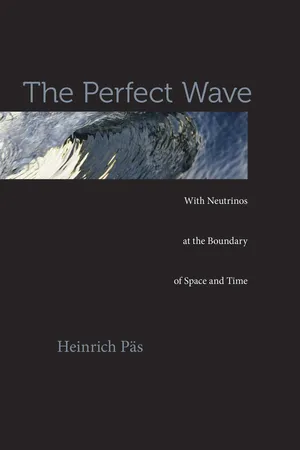![]()
1
Dawn Patrol in Honolulu
As a postdoc you have the craziest job in the world.
You get your PhD with honors at one of the best universities, and at the same time they kick you out. You apply everywhere in the world, and you have not the faintest clue on which continent or in which time zone you will end up. Then you get a new job at a different university, and you can come and go whenever you want and do whatever you want. You can just think about the most esoteric questions that come to your mind: What is all matter made of? What is happening at the beginning and at the end of the universe? What is time? All that is required is that you write down whatever insights you gain and publish them in scientific journals. Until two years later and irrespective of how good you were—then you get kicked out again, and the whole story repeats itself.
This was the reason I was standing, on this February morning’s dawn, on a beach on the other side of the world. With my Danish friend Ketil I stared, shivering, into Waikiki’s surf, rolling in from the endless Pacific (Fig. 1.1). Finally one of us brought himself to push his board into the water and started to paddle out toward the break, while the sun slowly climbed over the rim of Diamond Head crater.
Figure 1.1. View over Waikiki to Diamond Head crater. (Courtesy Ullstein Bild/Prisma/Steve Vidler)
Surfing in Hawai‘i ranks somewhere between national sport and religion—an active ceremony honoring the Hawaiian god Lono.1 What is most impressive for me about surfing, though, is the suddenness of the experience. In the beginning the water is often totally glassy, but after paddling out for a few hundred meters you reach the reef. Bathed in the first sunlight, a tiny fluctuation created by a storm thousands of miles away grows—as if caused by magic—into a wave. Soon the wave transmutes into an impressive greenish blue wall, a wall that—if after many failed tries, with tired arms and a headache, you manage to catch—accelerates you breathlessly and throws you into an ocean of adrenaline as it breaks into a carpet of snow-colored whitewater.
Physics ideas are like the Hawaiian surf. They seem to come from nowhere, they catch you suddenly without warning, and they draw you into an exhilarating trip. Later, on such days, I would sit in seminars daydreaming of breaking waves, or I would wander restlessly over the Manoa campus of the University of Hawai‘i, gazing at the cliffs overgrown by rain forest, while my brain untangled a clutter of film clips of the surf and thoughts about my present physics project. On one of these afternoons the following thought occurred to me: Assume that our universe, with its three space and one time dimension is embedded in a larger space with many extra dimensions. Our universe, lying there like the carpet in your living room. Could this carpet buckle? Assume further that there are elementary particles that can propagate not only in our common 3 + 1 dimensions but in the whole extra-dimensional space. Could these particles—instead of following the carpet buckles—take a shortcut along the floor? Could they make a “duck dive,” like a surfer diving underneath an incoming wave while paddling out? Could they in this way be faster than everything moving along the bumpy surface? How would it look, then, for an observer on the carpet, or the ocean-surface universe, if these particles traveled even faster than light? Could they actually—according to a well-known paradox in Einstein’s relativity—travel back in time?
At first glance, any single part of this idea seems crazy. Why should the universe have more than three space dimensions? And even if there were reasons, where in the world should these extra dimensions be? What’s the nature of these exotic elementary particles? And why should our universe have even the slightest similarity to a buckled carpet or the surface of the Pacific Ocean on a winter day? Why should something that moves faster than light be able to travel backward in time? How could this be possible at all?
This is all part of a long story, whose beginnings date back more than 3,000 years to ancient Greece. A story that continued in the 1920s at Europe’s universities, and has been augmented by science fiction and recent experiments at the most advanced laboratories for elementary-particle physics—CERN in Geneva, Switzerland, and Fermilab near Chicago. A true story that at times resembles a mystery thriller, with secret cults, dead philosophers, mind-expanding drugs, the mysterious disappearance of brilliant scientists, subterranean research labs, and experiments in Antarctica. It is a story of an elementary particle that, just like the Silver Surfer in the superhero cartoons, surfs to the boundaries of knowledge, of the universe, and of time itself. A story that captivates you as it sucks you into a maelstrom like an oversized wonderland.
Jump on your board and hold tight.
![]()
2
Eleusis, Plato, Magic Mushrooms
Three-thousand-year rewind: It was the ancient Greeks who began to consider the world as an object and who undertook its first rational analysis. It was they who laid the foundation for the scientific method and the Western worldview. It seems, however, that the Greeks also suffered from a divorce of ego and world, of subject and object. Deeply hidden in their souls, it seems, was the need to perpetuate some portal to the ecstatic feel of the unity of everything that exists, of all being. As the German philosopher Friedrich Nietzsche enthused in the nineteenth century: “Did those centuries when the Greek body flourished and the Greek soul foamed over with health perhaps know endemic ecstasies? Visions and hallucinations shared by entire communities or assemblies at a cult? How now?… Should it have been madness … that brought the greatest blessings upon Greece?”1
Ecstasies, visions, and hallucinations had a place of their own in ancient Greece: About thirty kilometers down a highway northwest of Athens, situated between crude-oil refineries and a military airfield, the small city of Elefsina hosts the remains of what was probably the most secret and holy cult, then called Eleusis, of the ancient world. “Happy are they among earthly mortals who have seen these things, but who is uninitiate and who has no part in them never has such joys once dead, beneath in darkness and gloom,”2 says a Homeric hymn.
For more than 2,000 years Eleusis initiated up to 3,000 believers annually, among them Roman emperors and politicians such as Cicero, Hadrian, and Marcus Aurelius; poets such as Pindar, Pausanias, and Sophocles; philosophers such as Plato; but also slaves, prostitutes, and normal citizens. The rite celebrated the cycle of life and of the seasons, the unity of life and death.3 While the death penalty was imposed on those uncovering its secrets, its traces can be found even today in science and the arts.
According to legend, Persephone, daughter of Demeter, the goddess of fertility and harvest, had been raped by Hades, the god of death, while picking flowers. With the permission of Zeus, Hades abducted her into the underworld. On earth, meanwhile, her mournful mother Demeter let the fields wither, the flowers fade, and god and man starve. Finally Zeus, the lord of Mount Olympus, gave in and commanded his brother Hades to bring Persephone back to her mother and to the world of the living. The sly Hades obeys the command but feeds Persephone a pomegranate seed on her way up to the surface. When joyful Demeter at their reunion learns that Persephone ingested food in the realm of the dead, she realizes that her daughter cannot stay with her permanently: Everyone who eats food in the realm of the dead falls under the spell of the powers of death. Eventually Zeus and Demeter agree on a compromise: One-third of the year Persephone has to stay with Hades in the underworld, while Demeter mourns and winter governs earth, but two-thirds of the year Persephone can stay with her mother, during which time the fields bear plenty of fruit.
The celebration of the cyclic recurrence of Persephone evolved from its origins in archaic rites of fertility into an allegory of death and birth and the cycle of life. On top of that, it also marks the transition from the worship of Mother Earth, personified by Demeter, to the worship of a full panoply of Olympian gods and goddesses, which illustrates the crossover of an agricultural society into a society of warriors, leading eventually to modern individuation. And finally it symbolizes—through the reunion of the two goddesses—the recovery of the original unity within the cycle of nature, long lost in daily life even in those ancient times, thus loosening the tension that seems deeply implanted in the soul of ancient Greece.
For the aspirants in Eleusis, the cultic celebrations belonged among the most important experiences in their entire lives. In early summer they had already attended the minor mysteries and recognized Persephone’s death, preparing themselves for the major festivities in the late summer. They had fasted, washed themselves in the ocean, sacrificed a young pig, and, adorned with myrtle crowns, had followed the procession of the cult objects and statues of the gods on the holy street. On top of the bridge crossing the small river they had been abused and ridiculed. After their arrival in Eleusis they were consecrated to the goddess and followed the different stations of Demeter’s quest: horror, sorrow, and the joy of being reunited. They danced at the fountain and drank the kykeon, a brew of barley and mint; were once more purified with fire and air; were allowed to touch the holy womb and phallus; and witnessed the dreadful appearances at the entrance of Hades’s grotto, the portal to the underworld. Finally, after some time of searching, they found the sanctification hall, the Telesterion (Fig. 2.1), where they took the oath next to the holy fire and witnessed the holy showing of the cult objects. The highlight of the holy night was the appearance of Persephone herself. After the sacrifice of a male sheep, the death goddess was called up and eventually emerged in her incarnation as the goddess of fertility, illuminated in brilliant light, and carrying with her her son Brimos, the seed of life, back from the underworld up into the light. According to the cyclic symbolism of the ritual act, Demeter is identical to Persephone, and Brimos is Hades is Dionysus.4 The god of grain and prosperity is identical to the god of wine, fertility, and ecstasy. The father is equal to the son and thus the archetype of indestructible life.5
Figure 2.1. View into the sanctification hall, the Telesterion in Eleusis.
The comprehension of the Eleusinian cult, and in particular of the mysterious kykeon brew, took an unexpected twist when, on April 19, 1943, a young Swiss chemist started on what is now a legendary bicycle ride.6 Albert Hofmann was a rather conservative fellow, a person who would send a jar of homemade honey to his favorite poet, Ernst Jünger. Professionally he had experimented with different derivatives of lysergic acid, the common component of several alkaloids found in a cereal fungus known as ergot. When synthesizing lysergic acid diethylamide—in short, LSD—Hofmann noticed that his laboratory animals acted nervously, and he himself felt funny during a second synthesis a few years later. To explore this effect thoroughly, Hofmann took the risk of a self-experiment with the smallest dose for which he expected any reaction at all. What he didn’t know, though, was that LSD has an effect about a hundred times stronger than comparable psychoactive substances, and in this way he stoned himself into nirvana: Within less than an hour on his bicycle trip home from the lab, the serotonin neurons stopped firing while the postsynaptic neurons inside the locus coeruleus acknowledged every stimulus, with wild fusillades bombarding the limbic system and consequently the entire brain: “If the doors of perception were cleansed, every thing would appear to man as it is, infinite,” wrote William Blake in The Marriage of Heaven and Hell.7 “Break on through to the other side!” sang the Doors.8
My only personal experience with magic mushrooms started with a tram that would not operate since on its route a house was burning down and ended with my friend Olaf massaging the feet of a girl of nodding acquaintance on my sofa while I sat for half an hour in the bathroom laughing about the wall tiles. What I found so exhilarating was that what under normal circumstances would be a rather boring rectangular pattern became blurred and kept changing shape, transforming over and over into new arrangements and increasingly crazy and creative designs. On top of that, green dots were flickering on the white walls like emeralds, the outlines of all objects obtained an unaccustomed clarity, colors seemed to glow from inside, and the heater warped itself into the aggressive form of a futuristic weapon.
Persons who, like Hofmann, take LSD, mescaline, or magic mushrooms in high doses often give accounts of the following sensations:
• an extremely enhanced perception, in which objects wander in and out of the foreground depending on the focus of concentration;
• extreme colors and patterns made out of numerous repetitions of the same elements or geometrical shapes;
• synesthesia (the capability to see sounds as colors or shapes or to hear physical contact); and
• decomposition of ...


